When thinking about what to write about this month I realised that although we buy and sell quite a lot of Moorcroft, I’ve only written about one piece in our collection. I think it’s time for me to put another piece in the limelight, given that it’s been nearly 18 months since the last one.
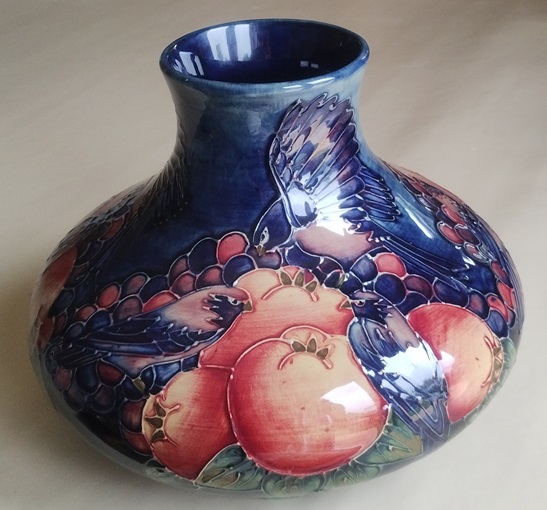
An introduction to the vase
The vase in question is a large, squat vase approximately 25cm across and 18cm high. Although it’s not usual to weigh ceramics, as an experiment, I did; the vase weighs 2.3kg. As such it’s a very substantial piece of pottery, one must handle it carefully yet firmly.
The design depicts picks sitting on and fluttering around fruit and berries. The background has the classic Moorcroft cobalt blue, which would have been familiar to William Moorcoft and his team in the early days of the company. Indeed the design is obviously a variation on, even a homage to, the classic Pomegranate designs of the early Moorcroft days.
The design is sometimes referred to as Finches and Fruit, Finches and Berries, Fruit and Finches, or Birds and Berries. The correct name for this design is simply Finches. It was one of a group of designs created by Sally Tuffin, whilst in her role as Art Director at Moorcroft.
Finches: A very important design
Finches was one of the designs that helped Moorcroft survive and then thrive following a very difficult period for the company in the mid-1980s. There are two excellent books that cover the history of Moorcroft: “Moorcroft” by Paul Atterbury and “Moorcroft: The Phoenix Years” by Frazer Street. My Finches vase falls into the late section of Paul Atterbury’s book.
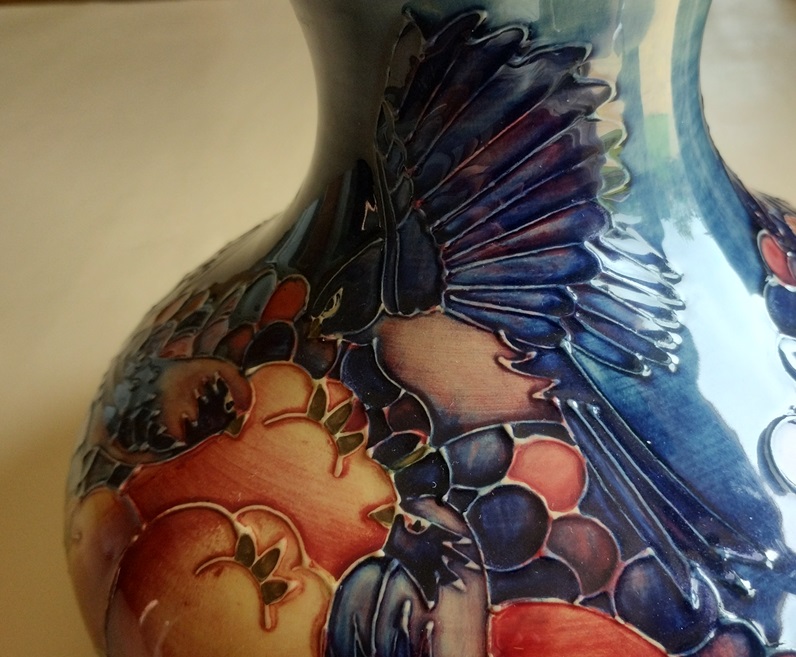
All the of designs produced by Moorcoft since the late 1980s owe a significant debt of gratitude to the success of the likes of Finches and Sally Tuffin’s talent. Without them Moorcroft would have probably ceased trading. Looking at our collection at home, and the quantity of Moorcroft we buy and sell, it’s quite hard to imagine how different our collection would have been.
Finches: A versatile design
As well as several colorways, Finches was used by Moorcroft on a remarkably wide range of products. Because of this it’s not difficult (in the UK at least) to find examples for sale at antiques fairs and auctions. Typical items are lamps, pin trays, pen trays, small, medium and large vases, ginger jars and of course occasionally the large squat vase similar to mine. If you see an image of a piece of Finches that you like, sourcing one should be possible as I don’t believe the design was used for any limited editions.
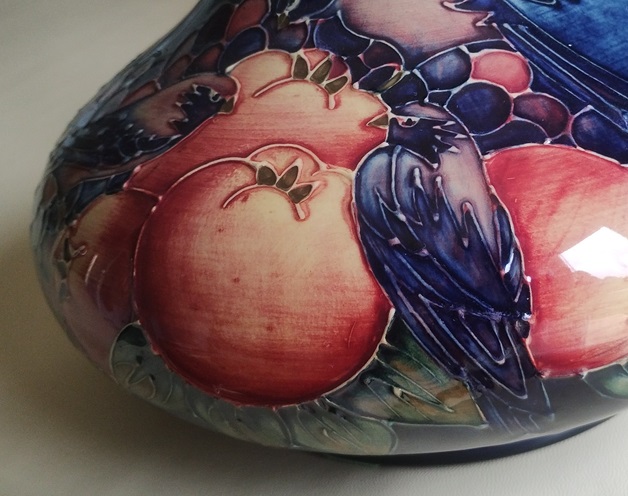
One of the brilliant aspects of the design is that it retains its essence even when scaled down. On a pin tray (a small circular dish) you get a single bird in flight with a few berries. We’ve had a couple of these and they generally sell quite well. On slightly larger items you get a second bird and, where space allows, a fruit. Then as the item gets larger you get to one complete copy of the design consisting of three fruit, two birds and a handful of berries.
On the large squat vase that I own, there is space for the full design three times around the circumference, with each pair of birds overlapping and tessellating into the next design.
To vary the design options further, Moorcroft used at least three different colourways. The vase I have uses the typical Moorcroft cobalt blue as the background. I’m less enamoured of a green version that crops up from time to time but I am very partial to a version with an ochre background that is somewhat rarer. Apparently it was only produced for about a year from 1989 to 1990. It’s quite striking how different these look to the original blue.
An extraordinary history
I bought my vase at the sale of the Felix Dennis Collection in 2014. Felix Dennis was a very successful publisher from the 1960s onwards and must have spent a considerable amount of time, money and effort collecting art and (to judge by the breadth of his collection) for want of a better word, stuff. On his death much of the collection was sold off in an extraordinary, three day sale conducted at his estate at Dorsington in Warwickshire.
I could claim to have been something of a near neighbour, living as I do in a modest house in a village about 10 miles from Dorsington. At Dorsington Felix Dennis owned the manor house, the associated estate and from the look of it a fair amount of the parish. It probably won’t come as a surprise to learn that we never met.
It’s an unfortunate reality that when the sale of a collection happens it usually follows the death of the collector. It’s something that buyers should always remember and be respectful of. When I come across collections I’m interested in I’m always struck by how much I’d have loved to meet the collector to ask about the things being sold. The Felix Dennis Collection was an extreme example of this. It was such an incredibly eclectic mix of things it’s such a shame that Felix wasn’t able to provide the back story to the items offered for sale. I’ve no doubt it would have been a fascinating and entertaining experience.
The Sale of the Felix Dennis Collection
The marquee that held the Felix Dennis Collection and the associated sale was massive. It’s hard to comprehend where all the items must have been before the sale, let alone the effort to bring it all together for the sale. If you’re interested in seeing the auction catalog, you can still find it on the internet.
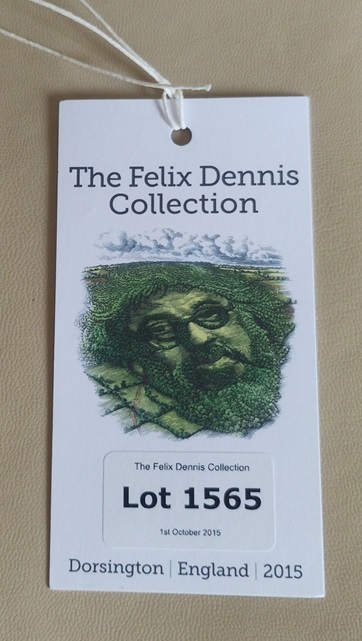
To give you an idea, from my memory, it included several pieces of Moorcroft ceramics, two aircraft ejector seats, a medieval chair and four modern copies, several rolls of very bright fabrics (which my wife tells me would have been very expensive), signed photographs of Felix with various rock bands, several sets of Fornacetti book ends with owls on them (I got out bid on every set), numerous sets of Robert Welch cutlery, and a stone carving of a sheep that was so heavy couldn’t lift it. There was also a standard lamp in the style of a Tiffany lamp in the shape of a toucan. I’ve always regretted not bidding on it.
The sets of cutlery were interesting because they demonstrate Felix’ apparent enthusiasm to buy from local suppliers if he could. The cutlery would have come from the Robert Welch shop in Chipping Campden. The enthusiasm for buying locally followed through to the auction of his collection since this was lead by Bigwood Auctions of Stratford upon Avon. In recent years I’ve got to chat to Mark Ashley of Bigwood. Mark was one the main auctioneers for the sale. Even for a very experienced auctioneer it was clearly one of the highlights of his career.
My vase and a possible history for it
I can never know the history of my vase for certain other than it was in the Felix Dennis collection. However, BW Thornton in Stratford upon Avon are the most likely retailer. If you’re not familiar with the shop I would strongly recommend a visit to their web site or better still, the shop. A stunning collection of Moorcroft is always on display.
I once mentioned the vase and it’s previous owner to Barry Thornton and his face lit up. He asked if I’d known Felix Dennis and seemed disappointed that I hadn’t. Barry described Felix in the most glowing terms. I would guess Felix was clearly one of Barry’s better customers! I think it’s a good bet that my vase came from Stratford, given Felix’ propensity for buying from local suppliers.
There is one other interesting connection that I wonder about. Felix Dennis made his name in London, starting in the late 1960s. As a lifelong party animal I assume Felix got to meet most of the people of significance in the London art scene in the 1960s and 1970s. This was the era when the designer of my vase, Sally Tuffin, was making her name as a clothes designer in partnership with Marion Foale. That Felix and Sally would have met each other is very likely.
What the vase can tell us about itself?
When you pick up a new piece of Moorcroft produce, the first thing to do is to turn it over. The base (or back if it’s a plate or plaque) of every piece will have some sort of information on it. Depending on its age this will vary, with modern pieces having most.
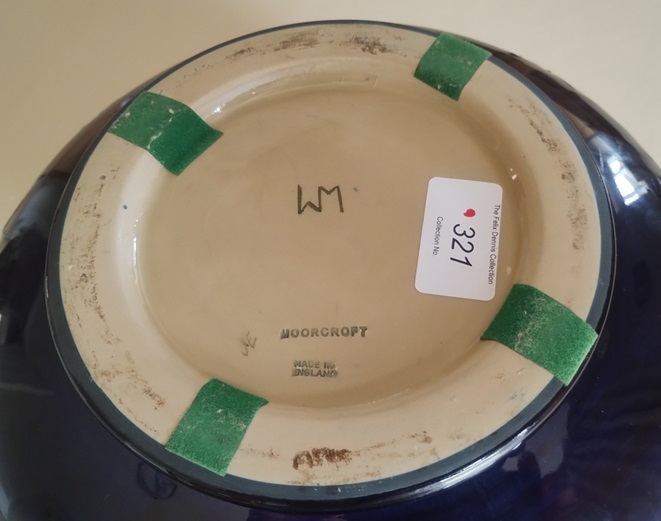
My vase has several points of information to interpret. We can start with the obvious one, the paper sticker. This related to the item collection from the Felix Dennis Collection auction. It’s no great ornament and I could remove it, indeed a future owner may well, but for me it’s now part of the vase’s history.
The very obvious WM monogram in the middle belongs to Walter Moorcroft. While Walter was still working, Sally Tuffin served as Art Director and many pieces bore Walter’s monogram. We also have the Moorcroft and Made In England impressed and overglazed marks. The font and style of these marks changed through time and in earlier pieces can provide the only dating information available.
The final letters, to the left of the impressed Moorcroft mark, are the painter’s mark of “ME”, for Mary Etheridge. A quick search for Mary on the internet brings up a lot of her work around this time but sadly no information beyond that. If you have a piece of a similar age and want to look up the painter you’ll probably need to invest in a copy of Paul Atterbury’s book “Moorcroft”. This is the definitive source for the listing of the painters’ marks. There doesn’t appear to be a listing on the internet.
In more recent times Moorcroft have made a big effort to allow collectors to identify the artists involved in making each piece. Coupled with details of the artists and designers on the Moorcroft website, this has been a very successful marketing tool to draw collectors in and to keep them interested.
The condition of the vase
I’ve written before about how I believe it’s important that modern pieces of Moorcroft should be in good condition and how sad it is to see them with substantial crazing. This vase came to me in perfect condition and it appears to remain so today.
It is rare for the vase to be handled or moved. However, I have to say that at the age the vase is getting to, it’s probably getting to the age where if crazing is “just a thing”, then it may well start to show. I’ve seen some pieces with the Finches design in a terrible state but I’m sure those pieces have just be mishandled. I expect the vase to remain in my possession for a long time to come so it will be interesting to see what happens.